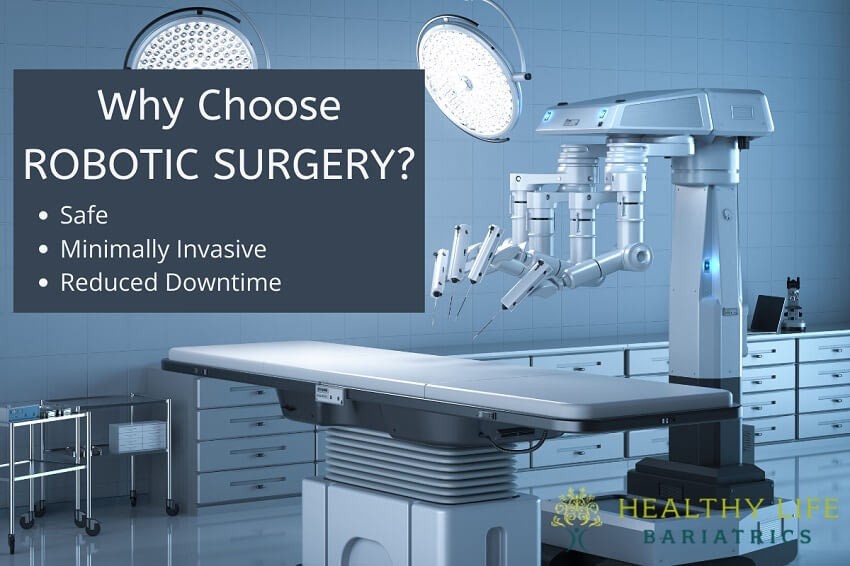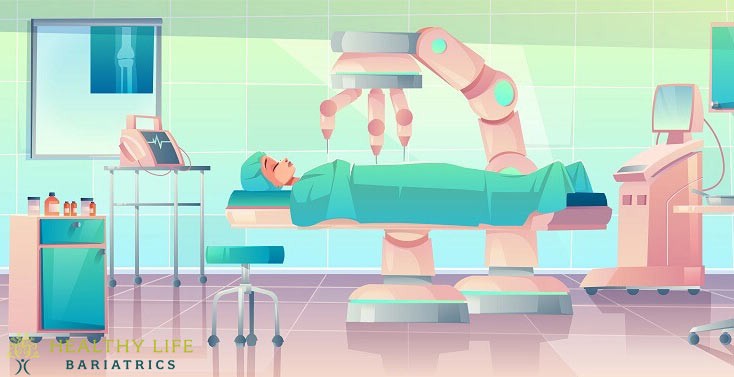
Robotic surgery sounds like a procedure out of Star Trek or Star Wars. You can almost imagine R2D2 standing over a patient on the operating table, using lasers to cut away tissue and suture wounds. You wouldn’t be far off the mark, except for the part about imaginary robot surgeons.
Robotic surgery is a thing. It’s used in today’s operating rooms and is safer and less invasive than many traditional surgical techniques. Suppose you are scheduled for surgery, whether it’s hernia, gastric sleeve, or any other type of surgery. In that case, hopefully, you are fortunate enough to find a doctor proficient in these advanced techniques.
Let’s explore what robotic surgery is, how it’s used, why it’s beneficial, and the various procedures the technology is known for.
Robotic surgery is also known as robot-assisted surgery. The technique allows doctors to perform complex procedures with super precision and control compared to conventional surgical techniques.
Robotic surgery is less safe, minimally invasive, and uses tiny incisions, though some surgeons also choose to use the technique with traditional ‘open’ surgeries.

Much like you would imagine out of a science fiction movie, robotic surgery uses a camera arm and mechanical arms with surgical instruments attached to them. Instead of being attached to an actual robot, the arms are attached to an adjustable stand. The surgeon controls the robot-like arms while seated at a computer console beside the sedated patient.
Looking at the console gives the surgeon a 3-D, magnified view of the surgical site. The surgeon guides other team members who assist during the procedure, while the robotic arms offer greater control and precision than is possible with human hands.
The most common robotic surgery uses include bariatric, hernias, gallbladder, and colorectal procedures.
This procedure is quickly becoming a favorite worldwide for patients with a high body mass index (BMI) who wish to lose weight safely and quickly. During a robotic gastric sleeve, the surgeon removes up to 75% of the stomach, reducing it to a sleeve the size and shape of a banana. This restricts the amount of food you can eat and makes you feel fuller and faster during meals.
Please read our article: Why Gastric Sleeve Surgery is Becoming a Favorite of Patients Worldwide.
Considered the gold standard of bariatric surgeries, robotic gastric bypass involves the surgeon creating a small pouch at the top of your stomach that forms a new stomach. This limits the amount of food you can eat during meals and helps you feel fuller and faster. The surgeon then makes a stoma (small opening) in the new stomach pouch and attaches that opening to a section of your small intestine. Following robotic gastric bypass surgery, you feel less hungry, eat less, and lose significant weight.
Please read our article: How Gastric Bypass Surgery Makes Weight Loss Easier.
For open hernia surgery, an incision is created in the groin, which enables the surgeon to locate the sac containing the bulging intestine. The surgeon pushes the hernia back into the abdomen before strengthening the abdominal wall using stitches or synthetic mesh.
During laparoscopic hernia surgery, the surgeon makes tiny incisions around the lower abdomen before inserting a laparoscope (thin tube with a tiny video camera attached). Carbon dioxide inflates the abdomen, creating space for the doctor to view the inside of your body. The surgeon cuts the inner lining of the abdomen (peritoneum) to enable them to observe the weakness in the abdominal wall. The mesh is positioned within the wall to cover the defects and reinforce the tissue.
Please read our article: Top Surgical Procedures for Hernias, Gallbladder Issues, and GERD.
Robotic surgery also removes the gallbladder during colorectal procedures, allowing for small incisions, nearly invisible scars, less pain, and reduced downtime.
Read our article: Gallstone Pain? Gallbladder Surgery Could Help
While robotic surgery technology is advanced, you should feel comfortable knowing the established techniques. Robotic surgery makes the various procedures safe and effective with lowered health risks.
Dr. Babak Moeinolmolki of Healthy Life Bariatrics is one surgeon who employs robotic surgery for bariatric (weight loss) surgery, hernia procedures, post-bariatric body contouring, and general surgery.
Read our article: Post-Bariatric Body Contouring Surgery Helps You Find Body Acceptance.
Dr. Moeinolmolki uses this surgery because the technology enhances precision. Robotic surgery allows for complex and delicate procedures that would otherwise prove difficult or impossible with traditional techniques.
Other reasons include the fact that there are fewer complications when robotic surgery is employed, such as site infections. Patients experience less blood loss and less pain overall, and the procedures are associated with shorter hospital stays and a shortened recovery.
Patients enjoy robotic surgery because of the lowered chances of injection, less pain, and the fact that there are smaller, less noticeable scars once the incision marks have healed.

Robotic surgical technology allows surgeons to use very small incisions. This is a sharp contrast to open surgeries that use elongated incisions to give the surgeon access to the inner workings of your body cavity. Since the incisions are smaller, the surgical techniques are considered less invasive. As such, you can look forward to a shorter hospital stay. You will also be able to return to your normal way of life sooner after surgery when compared to traditional surgical techniques.
All surgeries come with risks. Robotic surgery is no exception. For instance, there is always a risk of infection and other complications, though the risks tend to be diminished when robotic surgery is used.
While robotic surgery sounds like an android surgeon may work on you, you now know that this technology merely means that the surgeon has more control and greater precision, leading to better outcomes and improved patient safety.
Suppose you feel you are an ideal candidate for bariatric surgery, hernia surgery, gallbladder surgery, other general surgeries, and post-bariatric body contouring. In that case, robotic surgery may be right for you.
The best way to determine your candidacy for this advanced surgical technology is to schedule a consultation with Dr. Babak Moeinolmolki of Healthy Life Bariatrics. During the consultation, Dr. Moeinolmolki will discuss your surgical goals, the risks of robotic surgery, benefits, fees, and financing. Get started now by dialing (310)807-2378.